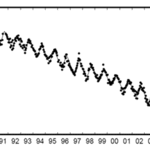Atmospheric

Scientists have fine-tuned computer models that can indicate when forest "carbon sinks" actually become net carbon generators instead.
The effort, detailed in Global Change Biology, will help pinpoint the effectiveness of trees in offsetting carbon releases that contribute to higher atmospheric temperatures and global climate change.
Since U.S. forests absorb and store about 750 million metric tons of carbon dioxide each year, managing forest resources to optimize carbon sequestration is essential to mitigating the effects of climate change, the authors say.
Researchers calibrated the Canopy…

As a result of the economic growth across much of Asia pollution from the region is being wafted up to the stratosphere during monsoon season, according to a new study in Science.
The new finding provides additional evidence of the global nature of air pollution and its effects far above Earth's surface.
Using satellite observations and computer models, the research team determined that vigorous summertime circulation patterns associated with the Asian monsoon rapidly transport air upward from the Earth's surface. Those vertical movements provide a pathway for black carbon, sulfur dioxide,…

Is there some way we can teach our children that there is no such thing as a free lunch? Perhaps then they will not grow up to think that problems can always be solved - if only we throw enough crazy unscientific ideas at them.
The laws of thermodynamics dictate a simple policy of universal application. It is one that policy makers must be forced to understand: mother nature will not permit us to reverse a fossil fuel energy production process without using more energy than the process has itself released.
One of the most ludicrous ideas I have ever read about, purportedly coming…

A new study in Environmental Science and Technology suggests that controlled burns release substantially less carbon dioxide emissions than wildfires of the same size and could be used to help the United States reduce its contribution to climate change.
Drawing on satellite observations and computer models of emissions, the researchers concluded that widespread prescribed burns can reduce fire emissions of carbon dioxide in the Western U.S. by an average of 18 to 25 percent, and by as much as 60 percent in certain forest systems.
Wildfires often destroy large trees that store significant…

New satellite data reveal that the amount of ultraviolet (UV) radiation reaching Earth's surface increased markedly from the period 1979 to 1998 and then stabilized, according to a study recently published in the Journal of Geophysical Research.
The primary culprit: decreasing levels of stratospheric ozone, a colorless gas that acts as Earth's natural sunscreen by shielding the surface from damaging UV radiation.
The finding, the author says, reinforces previous observations that show UV levels are stabilizing after countries began signing the Montreal Protocol, an international treaty…

CO2 emissions not only have a global impact but a local one as well. As a result of so-called carbon dioxide 'domes,' the greenhouse gas is harming city dwellers' health much more than rural residents', says a new study in Environmental Science and Technology.
The results, the author says, highlight a serious oversight in current cap-and-trade proposals, which make no distinction based on a pollutant's point of origin and provide scientific support for efforts to cut emissions locally.
Domes of increased carbon dioxide concentrations – discovered to form above cities more than a decade ago…
Wealthy consumers in the United States and Europe need to take the lead in efforts to prevent devastating climate change because they outsource their weather breaking carbon emissions to developing nations, according a new study in PNAS.
Researchers at the Carnegie Institution's Department of Global Ecology write that over a third of carbon dioxide emissions associated with consumption of goods and services in many developed countries are actually emitted outside their borders. Most of these emissions are outsourced to developing countries like China.
Since many developing countries are…

An international research team writing in Science says that a section of the Arctic Ocean seafloor that holds vast stores of frozen methane is showing signs of instability and widespread venting of the powerful greenhouse gas.
The results show that the permafrost under the East Siberian Arctic Shelf, long thought to be an impermeable barrier sealing in methane, is perforated and is leaking large amounts of methane into the atmosphere. Release of even a fraction of the methane stored in the shelf could trigger abrupt climate warming.
Methane is a greenhouse gas more than 30 times more potent…
While much attention has been given to the potential global impact of climate change, less has been paid to how a warmer planet would affect regional climates. The Intergovernmental Panel on Climate Change (IPCC) projects that the global average temperature will rise about 1°C by the middle of the century, but the global average does not tell us anything about what will happen to regional climates, for example rainfall in the western United States or Hawaiian Islands.
Analyzing warming projections in models used by the IPCC, a team of scientists claim that ocean temperature patterns in the…

Ships blowing off steam are aiding researchers who are studying how manmade particles might help mitigate climate change. New results from modeling clouds like those seen in shipping lanes reveal the complex interplay between aerosols, the prevailing weather and even the time of day the aerosol particles hit the air, according to research to be presented Saturday morning at the American Association for the Advancement of Science's annual meeting.
Previous work analyzing clouds in shipping lanes showed that large ships spewing tiny particles into the sky change the characteristics of clouds.…